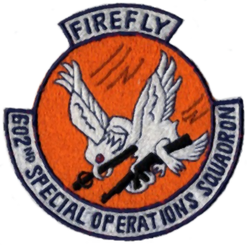
Summary
The 602nd Special Operations Squadron was a United States Air Force squadron that operated in Southeast Asia during the Vietnam War.
| 602nd Special Operations Squadron | |
|---|---|
 A Douglas A-1H Skyraider of the 602nd Special Operations Squadron over Vietnam in June 1970 | |
| Active | 1944-1945; 1963-1970 |
| Country | |
| Branch | |
| Role | Close air support and search and rescue (SAR) escort duty |
| Nickname(s) | Firefly |
| Decorations | Presidential Unit Citation Air Force Outstanding Unit Award with Combat "V" Device Republic of Vietnam Gallantry Cross with Palm |
| Insignia | |
| 602nd Special Operations Squadron emblem |  |
History edit
The 602nd Fighter Squadron (Commando) was activated in May 1964 for the Vietnam War, and along with the 1st Air Commando Squadron, was a part of the 34th Tactical Group. The squadron became operational at Bien Hoa Air Base on 15 October 1964. By 1966 the squadron had been renamed the 602nd Air Commando Squadron and moved, first to Nha Trang Air Base in South Vietnam, and then to Udorn Royal Thai Air Force Base, Thailand. In March 1968 it moved again to Nakhon Phanom Royal Thai Navy Base. On 1 August 1968 it was redesignated the 602nd Special Operations Squadron, and was inactivated on 31 December 1970 at Nakhon Phanom. The original Squadron patch was drawn by Walt Disney in 1944. The sky was blue with a wisp of cloud behind the left wing of the eagle. No call sign was mounted above the patch.[citation needed]
The squadron operated A-1 Skyraiders under the call sign "Firefly". Their daylight task was the primary one of combat search and rescue of air crew downed in the Kingdom of Laos. A secondary task was night operations as flareships supporting the Hmong guerrillas of General Vang Pao's Clandestine Army in the Operation Barrel Roll area.[1] At times, the squadron flew single ship sorties; they would also sometimes mark their own targets for their air strikes.[2]
Lineage edit
- Constituted as the 2nd Fighter Reconnaissance Squadron on 11 April 1944
- Activated on 20 April 1944
- Redesignated 2nd Fighter Squadron, Commando on 2 June 1944
- Inactivated on 12 November 1945
- Disbanded on 8 October 1948
- Reconstituted, redesignated 602nd Fighter Squadron, Commando, and activated on 15 April 1963 (not organized)
- Organized on 1 May 1963
- Redesignated 602nd Special Operations Squadron on 1 August 1968
- Inactivated on 31 December 1970
Assignments edit
- Third Air Force: 20 April 1944
- 2nd Air Commando Group: 22 April 1944 – 12 November 1945
- Tactical Air Command: 15 April 1963 (not organized)
- 1st Air Commando Group (later 1st Air Commando Wing): 1 May 1963
- Pacific Air Forces: 1 October 1964
- 34th Tactical Group: 18 October 1964
- 6251st Tactical Fighter Wing: 8 July 1965
- 3rd Tactical Fighter Wing: 21 November 1965
- 14th Air Commando Wing: 8 March 1966
- 56th Air Commando Wing (later 56th Special Operations Wing): 8 April 1967 – 31 December 1970
Stations edit
- Lakeland Army Air Field, Florida, 20 April 1944
- Cross City Army Air Field, Florida, 9 June 1944
- Alachua Army Air Field, Florida, 21 June 1944
- Drew Field, Florida, 17 August 1944
- Lakeland Army Air Field, Florida, 22 August 1944 – 23 October 1944
- Kalaikunda, India, 15 December 1944
- Cox's Bazar, India, 13 February 1945
- Kalaikunda, India, 14 May 1945 – 22 October 1945
- Camp Kilmer, New Jersey, 11 November 1945 – 12 November 1945
- Eglin Air Force Base Auxiliary Airfield#9, Florida, 1 May 1963
- Bien Hoa Air Base, Vietnam, 12 Oct 1964
- Nha Trang Air Base, Vietnam, 1 Feb 1966
- Udorn Air Base, Thailand, 15 Dec 1966
- Nakhon Phanom Royal Thai Naval Air Base, Thailand, 30 Jun 1968 – 31 Dec 1970
Aircraft edit
- North American P-51D Mustang, 1944–1945
- North American F-6 Mustang, 1945
- Douglas B-26B/C Invader, 1963–1964
- Douglas A-1E/G/H/J Skyraider, 1964-1970.
Operations edit
- Combat in CBI Theater, 14 Feb-9 May 1945
- Combat in SEA, 1964-1970
Campaign streamers edit
- World War II:
- Central Burma.
- Vietnam:
- Vietnam Advisory;
- Vietnam Defense;
- Vietnam Air;
- Vietnam Air Offensive;
- Vietnam Air Offensive, Phase II;
- Vietnam Air Offensive, Phase III;
- Vietnam Air/Ground;
- Vietnam Air Offensive, Phase IV;
- Tet 69/Counteroffensive;
- Vietnam Summer-Fall 1969;
- Vietnam Winter-Spring 1970;
- Sanctuary Counteroffensive;
- Southwest Monsoon;
- Commando Hunt V.[citation needed]
Decorations edit
- Distinguished Unit Citation: Bangkok, Thailand, 15 Mar 1945.
- Presidential Unit Citations: Vietnam: 1 Jul 1965 – 30 Jun 1966; 1 Jul 1966-7 Mar 1967; 12 Apr-30 Jun 1967; 1 Nov 1968 – 1 May 1969; 1 Oct 1969-30 Apr 1970.
- Air Force Outstanding Unit Award With Combat "V" Device: 1-31 Dec 1970.
- Republic of Vietnam Gallantry Cross with Palm, 1 Apr 1966 – 31 Dec 1970.
References edit
- Anthony, Victor B. (1973). The Air Force in Southeast Asia: Tactics and Techniques of Night Operations 1961-1970. Office of Air Force History. (2011 reprint). Military Bookshop. ISBNs 1780396570, 978-1780396576.
- Bailey, Carl E., Lineage and Honors History of the 602 Special Operations Squadron USAF Official History; Reviewed by A. Timothy Warnock; AF Historical Research Agency, Maxwell AFB, Alabama 2005.
- Marrett, George J. (2002). Cheating Death: Combat Air Rescues in Vietnam and Laos. Smithsonian Institution Press. ISBN 1-58834-104-6.


